ASUS ML248H: Thin for the Win?
by Chris Heinonen on October 27, 2011 12:00 AM ESTBrightness and Contrast
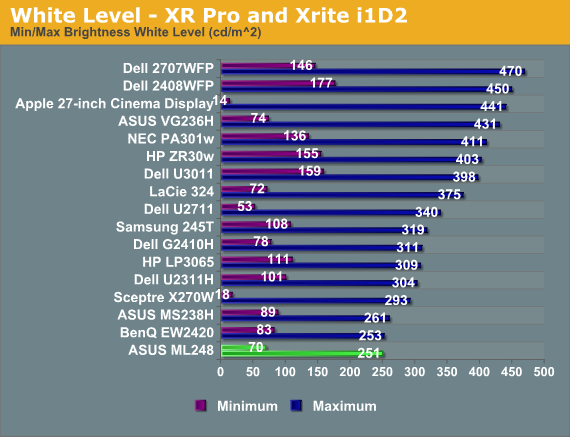
Even with contrast and brightness increased to their maximum values, the ASUS is not a light canon at all. The most I could get out of it was 251 nits, though that is brighter than I would ever use it. When at the minimum brightness level, the ASUS produces 70 nits of light output, which is a bit dim.
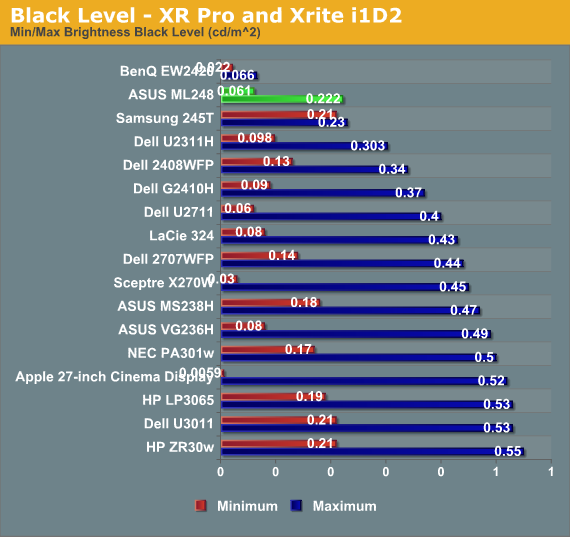
With the brightness back to maximum, the black level only registers at 0.222 nits, whereas with the backlight at minimum we got a black level reading of 0.061 nits.
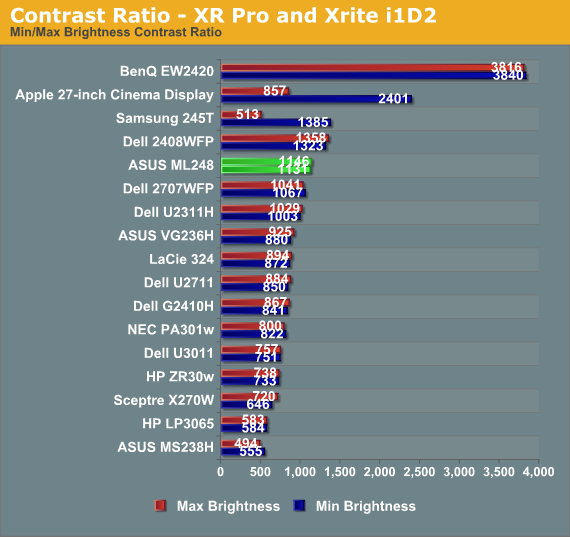
Looking at these in combination, the ASUS is producing contrast ratios of 1131:1 and 1146:1. It looks like whatever brightness level you want to set should work for you with the ASUS, and you can likely expect a contrast ratio of just over 1000:1 as well.
Brightness Uniformity
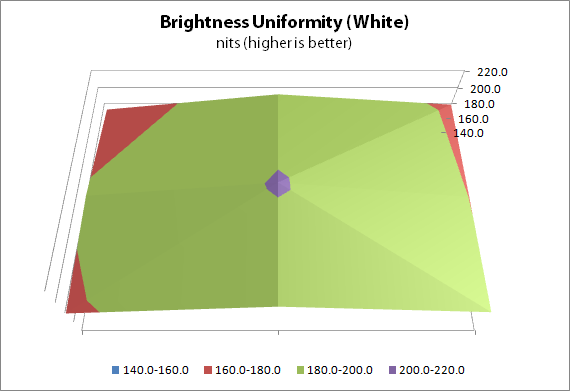
We saw earlier that the color uniformity of the ASUS was not up to par, so I wasn’t sure how the brightness and contrast would be in similar testing. With the center of the screen calibrated to 200 nits on a white screen, the ASUS is around 190 nits at the top and bottom of the center of the screen, but closer to 180 nits at the edges.
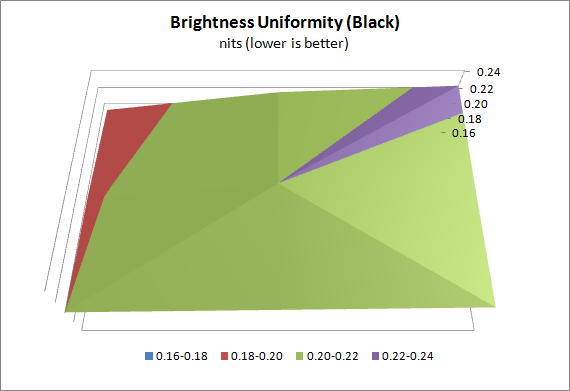
With an all black screen, the ML248H measures 0.22 nits in the center and drops slightly to 0.19 or 0.20 on the edge. These are very small differences, though, and are well within the margin of error for a dark reading from the light meter we use for testing.
I’m not certain what the LED alignment is for the ASUS ML248H, and they haven’t responded to my questions, but I’d guess that however the diffuser is set up for the lights is causing them to have an uneven light distribution across the whole screen, perhaps by having the LEDs themselves centered at the top and bottom of the screen. In any case, this non-uniformity could also be causing the color shifts in our dE uniformity testing. The panel is probably being driven exactly the same at the edges, but the spectrum of light passing through it is different, causing these issues.
I’m not sure if ASUS can fix this by using a different diffuser, or LEDs around the whole edge of the screen, or they might have to go to an LED backlit model to fix it. As I also review home theater displays, LG has recently introduced their Nano LED backlit sets for the home, which keep the slim form factor but provide all the backlit LED benefits like better contrast ratios and more even lighting, so perhaps we will see those in a desktop LCD soon.










57 Comments
View All Comments
Exodite - Thursday, October 27, 2011 - link
Gladly.Point being that not everyone appreciates, or even sees, the same thing.
Displays are entering an era of holier-than-thou douchebaggery (I just made up a word!) that has long been reserved for audiophiles.
The analogy is apt, I've yet to come across a modern computer where I've considered it worth the money to upgrade from integrated audio solutions.
Same holds for TN vs. IPS, PVA/MVA etc.
Broheim - Thursday, October 27, 2011 - link
lol@"TN is still the best", IPS is superior in every way except for response time, not just color reproduction... and e-IPS is damned cheap.Xajel - Thursday, October 27, 2011 - link
for that price, I think it's okay, but there's better solutions...the most con. - for me - about this other than the quality of TN display is lack of VESA mount, but it's TN quality alone is a good reason to stop me from taking it !!
ProDigit - Thursday, October 27, 2011 - link
I'd be glad if I won it, eventhough it's far from a winner monitor!Right now, I'm more looking into supersized monitors, that are like 38-42in in size for my PC!
rsgeiger - Thursday, October 27, 2011 - link
I logged in just to say that this monitor has the ugliest bezel I have seen in my entire life! It doesn't help if it is thin if the front facing side has no redeemable qualities.I know this didn't offer much to the conversation, and I apologize for that. But i could not in good conscience let this go unchallenged.
mcturkey - Thursday, October 27, 2011 - link
I have to agree with you. I don't understand the fascination with making LCDs any thinner than they already are unless you're also going to reduce the size of the bezel. Show me the 25-30" screens with 1-2MM bezels!cheinonen - Thursday, October 27, 2011 - link
My issue with making these displays so thin is that it necessitates an external power brick for them, which just makes my workspace more of a cluttered mess. With TVs I understand the fascination, since they are far more likely to be wall mounted and you want them to be as unobtrusive as possible, but LED LCD TVs still have room for a regular power supply and IEC power cord instead of an external power brick. I'd rather have a larger display with no external power brick, but perhaps I am in the minority now.ProDigit - Friday, October 28, 2011 - link
I always put my bricks and cabling behind my desk. No worries, no clutter (just between the desk and the wall, where no one sees them).Exodite - Thursday, October 27, 2011 - link
Word.JarredWalton - Thursday, October 27, 2011 - link
The article title is a question, you'll notice, as in, "Does making this a thin monitor actually make it better?" The answer, as you can read in our conclusion, is that there's nothing particularly compelling about this particular monitor. But hey, if someone has a better article title (that isn't outright insulting to ASUS -- no reason to be rude), let's hear it.